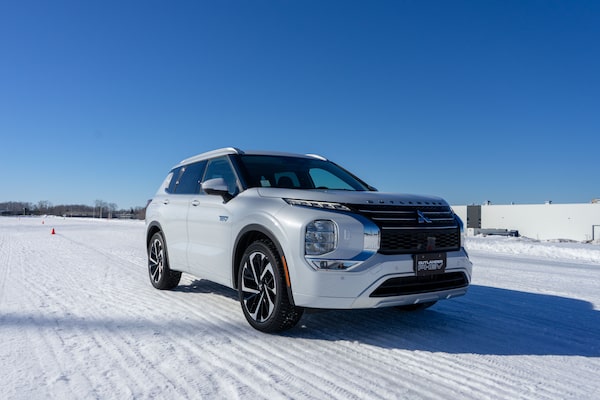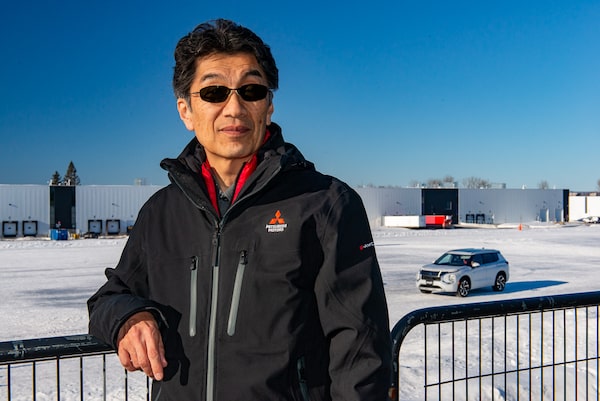
A 2024 Mitsubishi Outlander PHEV at an event to show its all-wheel-drive system in Laval, Que.Kunal D'souza/The Globe and Mail
There’s a small badge on the tailgate of the 2024 Mitsubishi Outlander plug-in hybrid electric vehicle identifying that it has S-AWC or Super-All Wheel Control, the brand name that the company has given their all-wheel-drive system.
Most manufacturers today market their version of this technology with its own moniker like xDrive, or 4Motion but it all means the same thing: The vehicle is fitted with the option to drive all four of its wheels.
There are different types of these systems, but the theory behind them is similar: Power is sent from the wheels that are slipping to the wheels that have grip. It’s how all-wheel-drive vehicles find more traction than two-wheel-drive vehicles in slippery conditions.
This hasn’t always been the case. In the mid-1970s, most vehicles were rear-wheel drive, according to the U.S. Department of Energy. By the mid-1980s, front-wheel drive was dominant and, as of a couple of years ago, most cars sold in the United States were all-wheel drive. According to automotive research company JATO Dynamics, more than 70 per cent of cars sold in Canada in 2020 were capable of sending power to all four wheels. All-wheel drive may have been for SUVs at first, but now even most sedans sold here come equipped with it as standard.
To say all-wheel drive has been a successful selling feature for all brands in Canada would be an understatement. And a big part of how the modern systems work comes directly from a carmaker that sells in relatively small numbers in Canada.
Early all-wheel-drive systems could transfer power between the front and rear wheels, but to improve the performance of rally cars in races, in 1996 Mitsubishi engineers developed a way to transfer power between wheels on the same axle.

Kaoru Sawase, an engineer at Mitsubishi Motors Corporation, in Laval.Amee Reehal/The Globe and Mail
Kaoru Sawase, an engineer at Mitsubishi Motors Corp., is known as the “godfather” of S-AWC among his colleagues. The badge first appeared on the now discontinued Lancer Evolution X, the last and final iteration of the legendary sports sedan and rally car. Sawase joined Mitsubishi in 1988 and worked on the maker’s four-wheel-drive technology from the beginning.
Transferring power between wheels on the same axle didn’t come until 1996. Nissan and Porsche both used an electronically controlled centre differential all-wheel-drive system, but could only transfer power from the rear axle to the front. Power transfer laterally on the same axle was Sawase’s invention.
“My first development was the Galant VR-4,” Sawase said at a Mitsubishi event in Laval, Que. in February. “It’s the first time we installed electronically controlled centre-differential for the four-wheel-drive system.”
Sawase said only the 1989 Nissan GT-R had an electronically controlled centre-differential type four-wheel drive system in Japan. He chuckles, “Before then, only Porsche.”
He was referring to the Porsche 959, one of the most advanced sports cars at the time. “I learned the technology from Porsche and Nissan,” he says.
They were both based on a rear-wheel-drive chassis and he adapted the technology to fit in the front-wheel-drive Galant, a mid-size commuter sedan. The VR-4 also incorporated four-wheel steering, four-wheel ABS and four-wheel independent suspension, all governed electronically. It was the first system of its kind.
The Galant VR-4 made its World Rally Championship debut in 1988 and won six rally events over the next four years until it was replaced by the smaller and more agile Lancer Evolution. The Evo, as it is often referred to, borrowed the engine, transmission and all-wheel-drive system from the Galant VR-4 and continued to dominate rally stages all over the world.
In 1996, the Lancer Evo IV was fitted with a new system called Active Yaw Control (AYC). “Before Lancer Evolution IV, we only had torque distribution front and rear, not lateral,” says Sawase. It was the world’s first example of a torque-vectoring system where drive torque can be split independently between the rear wheels.
“I invented it,” he says proudly. “I have many, many patents.”
The AYC system added another level of control to the already capable Lancer Evo. It’s for “cornering faster,” Sawase says with a grin.
It’s necessary to put the Evo into context here. It was based on the regular Mitsubishi Lancer, a compact economy car like the Toyota Corolla, meant for getting you around and not in any sort of style. But Mitsubishi was passionate about racing and outfitted their sedan with a drivetrain that gave it impressive performance. In an episode of BBC’s Top Gear, Jeremy Clarkson driving an Evo VIII is able to easily catch a £200,000 ($340,000) Lamborghini on the track.
The Lancer Evo developed a cult following among enthusiasts and the World Rally Championship (WRC) car is one of the most recognizable next to the equally famous Subaru Impreza WRC. Subaru and Mitsubishi were WRC rivals for many years, until Subaru pulled out of the WRC in 2008, and then Mitsubishi shortly after in 2010.
“I have many friends that are Subaru engineers,” Sawase said with a laugh. “Honestly speaking, I hope Mitsubishi Motors returns to racing.”
”Two years ago, we joined the Asian Cross Country Rally near Thailand with [a] Triton [pickup] and we won,” he says. “In order to return to WRC, we must make a special car and that’s very difficult.”
He explains that even though the S-AWC all-wheel-drive system in the Outlander PHEV uses electric motors now, the theory behind it and what was on the Lancer Evo is the same and that they are “directly connected.”